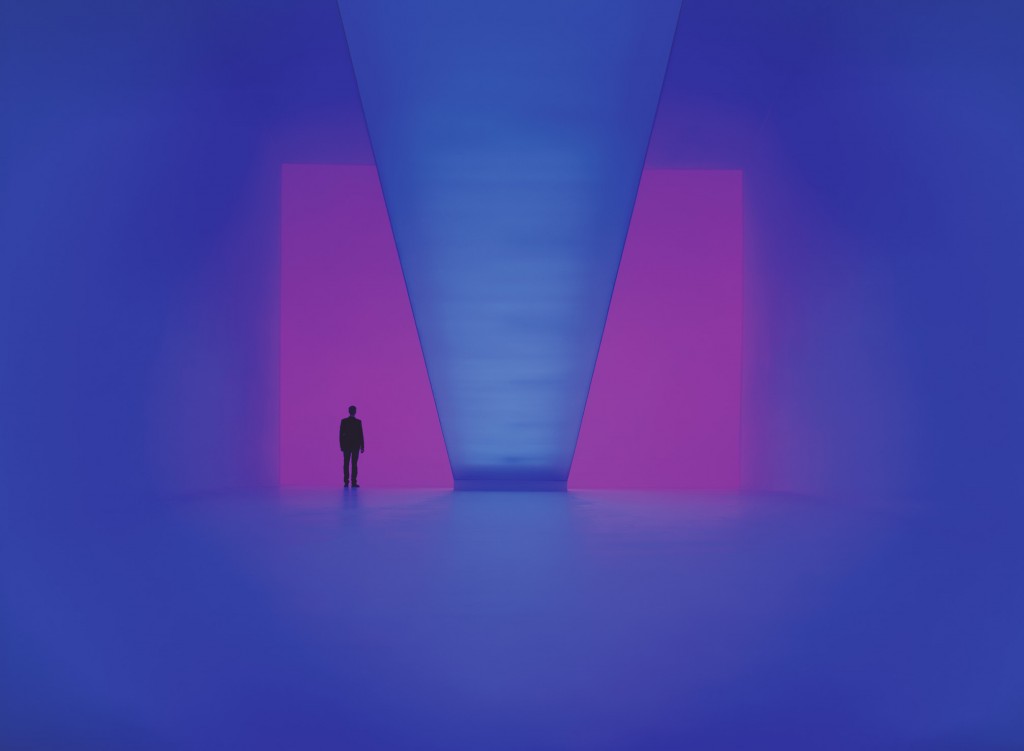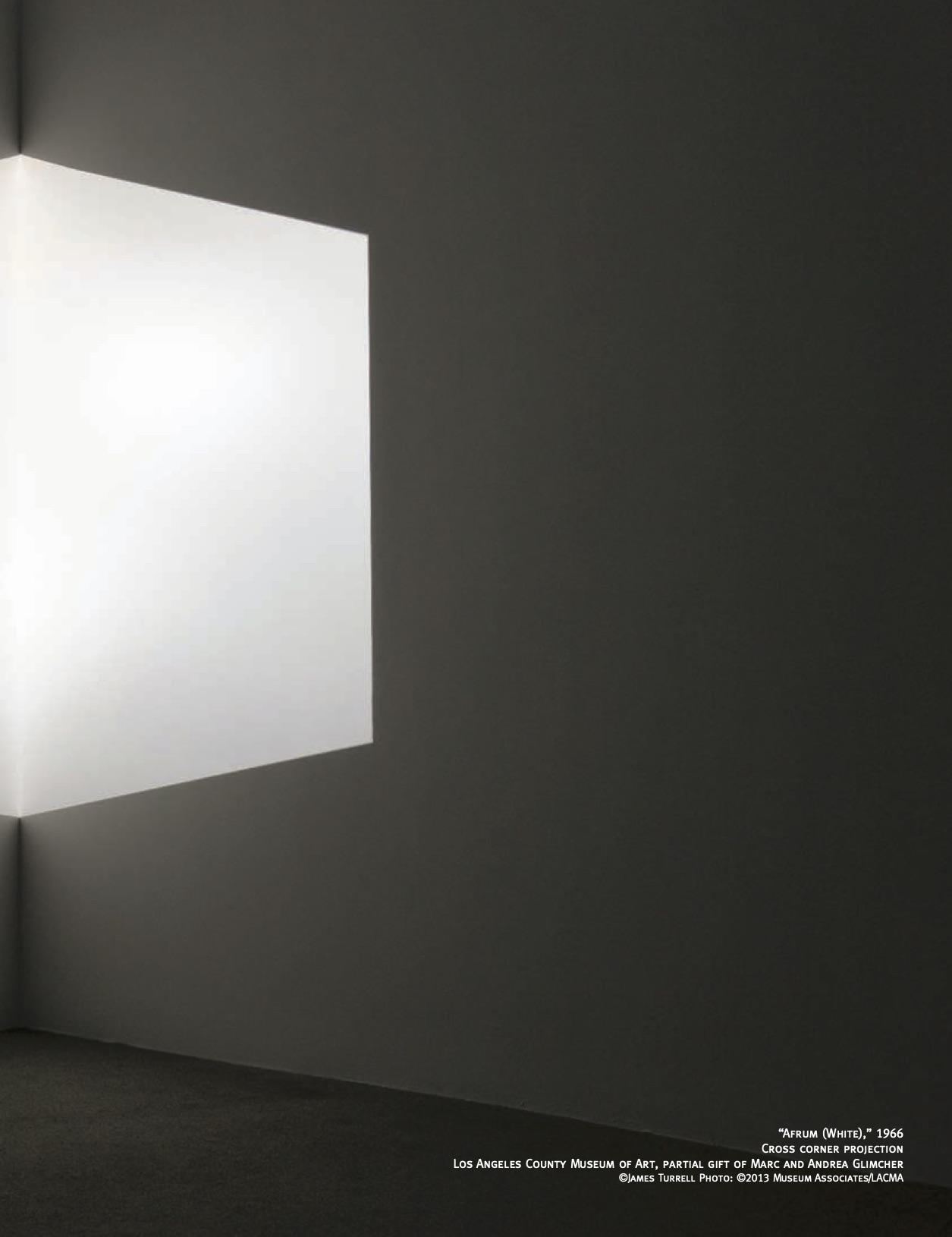James
Turrell
by Susannah Tantemsapya
ArtSlant
Originally published on art ltd. on July 1, 2013
Bridgit’s Bardo, 2009
Ganzfield Installation view at Kuntmuseuem Wolfsburg, Germany, 2009 Image Credits: ©James Turrell; ©Florian Holzherr
Courtesy: The Los Angeles County Museum of Art
2013 has proven to be a big year for James Turrell. With six concurrent exhibitions this summer--including solo shows at the Los Angeles County Museum of Art (LACMA), The Museum of Fine Arts, Houston (MFAH), and the Solomon R. Guggenheim Museum, in New York--the pioneering Light and Space artist has works on view prominently across the country; put together, these shows offer a comprehensive survey of his five-decade career. Considering perception to be his true medium, Turrell "arrests and apprehends light" to create immersive, ethereal experiences. Having just reached his 70th birthday, he remains an iconic figure; with this latest confluence of exhibitions, the artist's massive spectrum of work is moving even more decisively into public consciousness.
"How much we perceive is what we are a part of making," Turrell expressed during the May preview of "James Turrell: A Retrospective" at LACMA. This sprawling survey show represents his largest, traditional retrospective to date: spanning close to 3,400 square feet, divided between two buildings, it begins with his earliest projection pieces including his first light work titled Afrum (1966). Critical to both his career and to LACMA's permanent collection, it inspired the "thingness" of light, an invented term to describe the way something intangible can appear as physical matter. The show's chronology is interrupted with later works to convey ideas Turrell had at certain times, but was not able to achieve due to technology or materials. For example, his Hologram series started in the 1990s are indicative to the movement of light related to his early projection pieces.

"As in many of Turrell's works, there is an ideal way to enter into a light installation: the sight-line from the doorway, the way you approach a piece from far away and come closer to perceive the work. That's one consideration in how to lay out the show," observes Christine Y. Kim, co-curator of the LACMA exhibition with Director & CEO Michael Govan. "Secondly, some rooms require light locks with separation and segregation from other works. Some works require time, five minutes or more for a viewer's eyes to adjust. All the aspects to these different types of installations enhance the experience of the work. The other part is carving out a timeline and a narrative that illustrates the evolution in Turrell's work over the past 48 years."
"James Turrell: The Light Inside" at MFAH is named after his permanent commission for The Wilson Tunnel, connecting both buildings of the institution. The Houston show features seven installations, ranging from his first projections to his recent Tall Glass series. "We are working in a Mies van der Rohe building, with its very clean, reductive spaces, and the pavilion we built out for James' work is exactly the period from the beginning of his career. The two work together in a stunning visual harmony," says MFAH curator Alison de Lima Greene.
Turrell is perhaps best known for his Skyspaces, which transform a limitless, celestial sphere into a private, intimate viewing space. For each of these works, he cuts an aperture in the ceiling to imbue it with a symphony of colors, ideally viewed during a sunrise or sunset. There are 82 of these works to date in private and public venues worldwide. During the LACMA preview, Turrell jokingly referred to himself as being in the "business of selling blue sky and colored air."
Collaborations with creatives like Philip Glass and Karl Lagerfeld have contributed to the evolution of Turrell into a "full-service artist." He recently transformed Kayne Griffin Corcoran gallery in Los Angeles into a "meditative oasis." Set against the stark, white architecture of its new space, the lush landscape is composed of a bright magenta and green palette. There are programmed skylights to create optimal viewing, a new Skyspace in the gallery's conference room, and an exterior light installation at night.
"Turrell approached the project with the goal of enhancing the experience between art and architecture, and indoor and outdoor spaces," says gallerist Maggie Kayne. The location's inaugural exhibition, "James Turrell: Sooner Than Later, Roden Crater," is a historical overview of his magnum opus in the Arizona desert, a subject also addressed expansively in the LACMA survey. It also contains the artist's latest perceptual cell, called The Meditation Room (2013).

Aten Reign, 2013
On view at Solomon R. Guggenheim Museum New York, June 21 - September 25 Image Credits: David Herald; ©James Turrell; ©Solomon R. Guggenheim Foundation
Turrell earned a degree in perceptual psychology with extensive coursework in astronomy, mathematics, geology and art history. In 1969, he collaborated with Robert Irwin and Dr. Ed Wortz as part of the Art and Technology program at LACMA. He began to explore the depths of human perception through work in anechoic chambers, sensory deprivation and sleep labs. From that time, he started creating his Ganzfeld series (meaning "complete field" in German). Akhob (2013) in Las Vegas is his largest Ganzfeld project to date. This permanent commission is 77 feet long, 33 feet high and 44 feet wide. It fills the entire fourth floor of a Louis Vuitton store in an upscale CityCenter. The artist has also affected the interior light of the mall itself, installing several works and changing the monorail station into an interactive light manipulator for arriving and departing trains.
Turrell's grandmother would often encourage him "to go inside and see the light." Considering himself to be "lapsed" Quaker, the artist engages the spirituality of his upbringing along with scientific experimentation to create some of his most transcendental works. At LACMA, there is Breathing Light(2013) a 5,000 square foot piece that represents the Ganzfeld Effect and Dark Matters (2011), part of his Dark Pieces series where an attentive viewer can sense the Purkinje shift (dark adaptation). Described by NBC as the "hottest ticket in town," Light Reignfall (2011) can only be experienced by one viewer at a time; it has a several month wait list and a legal waiver as intense as the work itself. Part of his Perceptual Cell series, it blurs the boundaries of perception between the body and the mind. This 10-minute, kaleidoscopic experience has induced reactions ranging from psychedelic hallucinations to sickness to blissful meditation, depending on the viewer.
"There's this balance of fear and exhilaration," says Kim, of the work. "It's intended to take you into an alpha state, which is similar to light you see in a dream or behind the eyes, or close to meditation. As opposed to the excitement of a roller coaster, all of those things are about a submission and relaxation."


Then, of course, there's the Roden Crater, the monumental artwork and naked eye observatory that Turrell has been working on since 1979. He's completed Phase One of three phases, which will hold 20 chambers, tunnels and spaces for viewing the heavens. These shows, along with other major exhibitions at the Academy Art Museum in Easton, MD and Villa Panza in Varese, Italy, will help further his commitment towards its completion. (Meanwhile, his LACMA show remains on view through April 6, 2014.)
Turrell has been in 160 solo shows worldwide since 1967. With this new array of expansive exhibitions, his scope and reach is now as horizonless as some of his most profound works.
- Print -